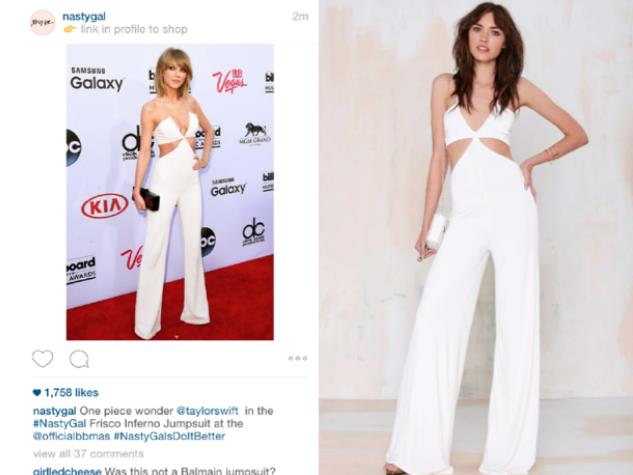The Instagram post and the Nasty Girl model, Image via Fashion Law
We’ve all seen it (on Instagram) before: a high-street brand advertising its cheaper version of a couturier’s statement piece. But it is way more cringe worthy when the fashion copycat tells everyone that the one and only Taylor Swift is wearing their design; only to discover that’s she’s actually not.
So, what’s the story here? Let’s rewind to May, when Nasty Gal, the US-based fashion retailer with a heavy social media presence, posted a picture on Instagram of Tay Tay at the Billboard Music Awards. The post boasted that she was wearing Nasty Gal’s white flared jumpsuit (retailing for US$45). It was all pretty exciting for Nasty Gal, until moments later when it was revealed that the jumpsuit wasn’t Nasty Gal’s but in fact French haute couture fashion house Balmain’s, which retails for US$2,000. [Insert awkward silence].
To avoid situations like this and protect your design from fashion copycats in Australia, we introduce to you the Designs Act 2003. A design is protected in Australia if it’s registered under this Act. Once registered, you’ll have enforceable rights for a maximum of 10 years to commercially use, licence, sell or protect your design.
A design is registrable if it passes the test of being ‘new’ and ‘distinctive’. That is, it must not be similar to any other design previously disclosed anywhere in the world (including the internet); whether or not it was independently developed. You can even register your design if it is just a sketch.
Some tips for budding designers on protecting your intellectual property rights:
- Do your research and ensure your design does not infringe someone else’s registered design. You can search design registers to assist in this process.
- Keep your design secret until the design is registered. Don’t exhibit it, sell copies of it or upload it onto the internet. If you don’t keep it secret you cannot register it.
- Once registered, include “registered design” statements on your swing tags to dissuade potential copiers.





